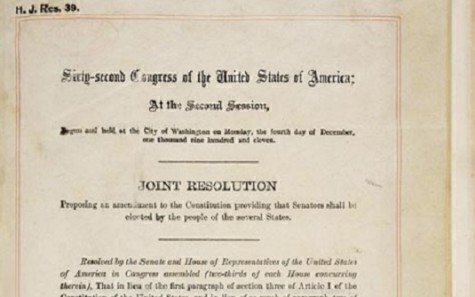It’s the 105th anniversary of the 17th Amendment, leading us to consider what today’s U.S. Senate would look like if its members weren’t directly elected by voters.
 The answer is simple: It would be probably be much more controlled by the Republicans, with a good chance that it could be a filibuster-proof majority and a chance it could be veto-proof.
The answer is simple: It would be probably be much more controlled by the Republicans, with a good chance that it could be a filibuster-proof majority and a chance it could be veto-proof.
Prior to 1913, when the 17th Amendment was ratified, state legislatures elected two U.S. senators to represent them in Congress.
Members in each state House and each state Senate, in most cases, would meet separately to pick a candidate as its representative in the U.S. Senate.
If the two caucuses picked the same person, the race was over and that person was sent to the U.S. Senate. (The elections were staggered so only one senator was chosen every two or four years.) But if different candidates were preferred for that one U.S. Senate seat, the legislatures met in a combined session until they could agree on a selection.
This indirect selection method had its flaws. Deadlocks could prevent a state from sending someone to Congress. Only 2 percent of the races ended in a deadlock--but these deadlocks were devastating, because they prevented patronage jobs from being appointed.
Jumping forward to 2018, Constitution Daily looked at the current composition of state legislatures to see how the U.S. Senate would look if it reflected how Democrats and Republicans currently control state Houses and Senates.
Using data from the National Conference of State Legislatures as of February 2018, Republicans control 32 state legislatures, the Democrats control 13 legislatures and 4 legislatures are split (Nebraska's unicameral legislature is not included). So that would roughly translate to 64 seats for the GOP in the current Senate (under the old pre-17th Amendment rules). That also would put the Republicans four votes over a filibuster-proof 60-vote majority and within three seats of a 67-vote supermajority needed to override a presidential veto.
The amendment ratified in 1913 still has its critics, particularly among states' rights advocates. Repeal proponents have pointed to several benefits. Foremost, it gives state governments a direct voice in the federal government and budgeting process, something proponents believe reflect the desire of the Founding Fathers for states to have a dynamic role in Washington.
But other factors would make repeal problematic. Only one amendment, the 18th, has ever been repealed, when the 21st Amendment ended Prohibition.
The anti-17th Amendment forces would need 38 states to ratify a repeal amendment, which is no small task, since two-thirds of Congress or the states would need to agree to offer one up for ratification votes.
Scott Bomboy is the editor-in-chief of the National Constitution Center.







